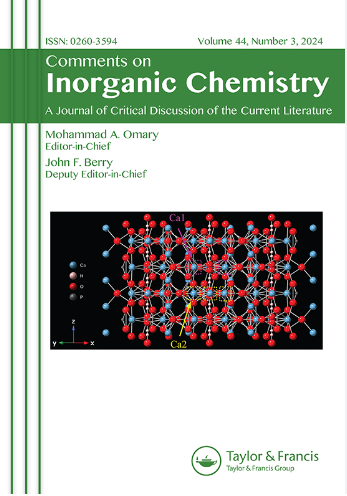具有可交换亚胺配体的发光,氧化还原活性二硫代酸(亚胺)铂(II)发散配合物:与二亚胺二硫代酸铂(II)收敛同族物的实验/计算研究
IF 3.8
3区 化学
Q1 CHEMISTRY, INORGANIC & NUCLEAR
引用次数: 0
摘要
本文提供了《无机化学评论》编辑们希望以以作则的新传统的第三种表现,即我们开始发表原创研究内容,尽管如此,仍保留了该杂志作为无机化学当代文学“批判性讨论”的定位。(关于第一和第二表现,见:(1)Otten, b.m.;梅兰康,k.m.;所有闪光的都不是黄金:d10金属中心的双金属配合物的共价与亲金键的计算研究:纪念Al Cotton逝世10周年,评论Inorg。化学,2018,38,1-35;(2)亚辛,w.k.;桑德斯,s.f.;阿尔莫塔瓦,r.m.;奥顿,b.m.;Bhat,美国;阿拉莫,哥伦比亚特区;马普,s.b.;金,t.d.;“金属配合物是‘有机’、‘无机’、‘有机金属’还是‘金属有机’材料?”使用三核金属配合物作为“金属有机涂层”在铝基板上抑制腐蚀的案例研究,”评论Inorg。化学,2019,39,1-26。在这里,我们对比了两类Pt(II)配合物与混合亚胺/硫原子配体的电子结构:一类新的[Pt(N^N)2(S^S)] (κ1-二亚胺)二硫代铂(II)发散式配合物,即只有一个N原子从“背对背”二亚胺配体上以非桥接单齿方式与Pt(II)中心配位,与-à-vis迄今为止研究得很好的[Pt(N^N)(S^S)] (κ2-二亚胺)二硫代铂(II)会聚同属物相比,二亚胺和二硫代都以κ2螯合双齿方式配位。因此,为了追求利用发光构建块来生成光捕获超分子配位化合物,我们报道了Pt(pyz)2(mnt), 1的合成、表征和高收率的反应性(pyz =吡嗪,mnt =马来腈二硫酸酯)。该配合物表现出吡嗪配体的溶剂依赖交换,可用于形成含有二硫酸铂基团的更大配合物。作为概念的证明,1已转化为更具惰性的Pt(4,4′-bpy)2(mnt), 2和Pt(4-ap)2(mnt), 3, (4-ap = 4-氨基吡啶)配合物。这些配合物具有氧化还原特性,是紫外线和可见光的强吸收剂,并在77 K下表现出明亮的发光。1和3的单晶x射线衍射分析证实了分子内Pt- s和Pt- n键长与其他(κ2-二亚胺)(二硫酸酯)Pt(II)型配合物的单位配位,而两个杂环由于缺乏相互系聚而表现出明显的扭转。发现了1晶体的溶剂依赖性稳定性,而3晶体的晶体结构揭示了一个有趣的超分子四边形,这是由两个配合物的胺基和两个间隙水分子之间的氢键引起的。本文提出了一篇评论,对比了这里的发散配合物与二亚胺-二硫酯类似物的电子结构。在实验中,发光被认为是在新的一类发散配合物中敏化的,因为它们缺乏对两个芳环的共轭,使得它们与类似的二亚胺(如2,2′-联吡啶(2,2′-bpy))相比,π受体的效率较低,因此向蓝/近紫外吸收蓝移,并有助于将发射保持在可见光区域内。因此,考虑能隙定律会抑制红/近红外区域的猝灭效应,特别是在有利于磷光和固态和高浓度流体和/或冷冻溶液聚集效应的实验条件下。对这三种不同的配合物加上二亚胺-二硫酯同族物Pt(2,2 α -bpy)(mnt)的单体模型进行的计算研究,与实验结构、光谱和氧化还原性质达成了合理的一致,并为两类配合物之间的比较提供了很好的见解,我们将重点讨论这两类配合物。计算的光物理性质揭示了由于高能级三重态而产生的磷光,因为T1在近红外区域发光,并且具有配体场(dd)跃迁起源,而高能级状态显示在可见光区域,接近实验磷光能量。并且与预期的电荷转移从混合二硫酯/铂的最高占据分子轨道(HOMOs)转移到亚胺/二亚胺最低未占据分子轨道(LUMOs)一致。T1态可能是这两类配合物在环境温度下发射强度消失的罪魁祸首。我们还发现中性激子和自由基极化子(阴离子或阳离子)的T1和D1态分别在1-3 vs Pt(2,2′-bpy)(mnt)模型中严重扭曲。 在Pt(κ1-亚胺)2(二硫代酸)的激发和氧化还原模型中,两个杂环可以达到近乎完美的正交性,而在Pt(κ2-二亚胺)(二硫代酸)模型中,由于其CCNNPt金属环的空间限制,这种畸变受到阻碍。图形抽象本文章由计算机程序翻译,如有差异,请以英文原文为准。
Luminescent, Redox-Active Dithiolatobis(imine)platinum(II) Divergent Complexes with Exchangeable Imine Ligands: An Experimental/Computational Study Versus Their Diiminedithiolatoplatinum(II) Convergent Congeners
This article provides a third manifestation of a new tradition by which the editors of Comments on Inorganic Chemistry wish to lead by example, whereby we start publishing original research content that, nonetheless, preserves the journal’s identity as a niche for “critical discussion” of contemporary literature in inorganic chemistry. (For the first and second manifestations, see: (1) Otten, B. M.; Melancon, K. M.; Omary, M. A. “All that Glitters is Not Gold: A Computational Study of Covalent vs Metallophilic Bonding in Bimetallic Complexes of d10 Metal Centers: A Tribute to Al Cotton on the 10th Anniversary of His Passing,” Comments Inorg. Chem. 2018, 38, 1–35; (2) Yaseen, W. K.; Sanders, S. F.; Almotawa, R. M.; Otten, B. M.; Bhat, S.; Alamo, D. C.; Marpu, S. B.; Golden, T. D.; Omary, M. A. “Are Metal Complexes ‘Organic’, ‘Inorganic’, ‘Organometallic’, or ‘Metal-Organic’ Materials? A Case Study for the Use of Trinuclear Coinage Metal Complexes as ‘Metal-Organic Coatings’ for Corrosion Suppression on Aluminum Substrates,” Comments Inorg. Chem. 2019, 39, 1–26.) Herein, we contrast the electronic structure of two categories of Pt(II) complexes with mixed imine/thiolato ligands: a new class of [Pt(N^N)2(S^S)] bis(κ1-diimine)dithiolatoplatinum(II) divergent complexes—whereby only one N atom from the “back-to-back” diimine ligand actually coordinates to a Pt(II) center in a non-bridging monodentate manner—vis-à-vis the hitherto well-studied [Pt(N^N)(S^S)] (κ2-diimine)dithiolatoplatinum(II) convergent congeners—whereby both the diimine and dithiolate coordinate as κ2-chelating bidentate. Thus, in pursuit of using luminescent building blocks to generate light-harvesting supramolecular coordination compounds, we report the synthesis, characterization, and reactivity of Pt(pyz)2(mnt), 1, in high yield (pyz = pyrazine, mnt = maleonitriledithiolate). The complex exhibits solvent-dependent exchange of the pyrazine ligands, which can be utilized in the formation of larger complexes containing platinum dithiolate moieties. As proof of concept, 1 has been converted into the more inert Pt(4,4ʹ-bpy)2(mnt), 2, and Pt(4-ap)2(mnt), 3, (4-ap = 4-aminopyridine) complexes. These complexes exhibit redox properties, are strong absorbers of ultraviolet and visible light, and exhibit bright-luminescence at 77 K. Single-crystal X-ray diffraction analysis for 1 and 3 confirms the monotopic coordination of the ligands with intramolecular Pt-S and Pt-N bond lengths being comparable to other complexes of type (κ2-diimine)(dithiolate)Pt(II), whereas significant torsion is exhibited by the two heterocyclic rings due to the lack of tethering to one another. Solvent-dependent stability is uncovered for 1 crystals, whereas the crystal structure of 3 reveals an interesting supramolecular quadrangle resulting from hydrogen bonding between the amine groups of two complexes and two interstitial water molecules. A commentary is presented to contrast the electronic structure of the divergent complexes herein with that of a diimine-dithiolate analogue. Experimentally, the luminescence is believed to be sensitized in the new class of divergent complexes, given that their lack of conjugation of two aromatic rings renders them less-efficient π-acceptors compared to analogous diimines such as 2,2ʹ-bipyridine (2,2ʹ-bpy), hence blue-shifting the absorption toward the blue/near-UV and assisting in keeping the emission well within the visible region, whereby energy gap law considerations would suppress quenching effects in the red/near-infrared regions, especially under experimental conditions conducive for phosphorescence and aggregation effects in the solid state and higher-concentration fluid and/or frozen solutions. Computational studies for monomeric models of the three divergent complexes plus the diimine-dithiolate congener, Pt(2,2ʹ-bpy)(mnt), attain reasonable agreement with experimental structural, spectroscopic, and redox properties and provide excellent insights for the comparison between the two categories of complexes upon which we focus the commentary section. The computed photophysical properties reveal phosphorescence due to higher-lying triplet states, as the T1 is found to luminesce in the near-IR region and entail a ligand-field (dd) transition origin, whereas higher-lying states are shown to be in the visible region, close to experimental phosphorescence energies, and are consistent with the expected charge transfer transition to imine/diimine lowest-unoccupied molecular orbitals (LUMOs) from admixed dithiolate/platinum highest-occupied molecular orbitals (HOMOs). The T1 state is likely the culprit for the vanishing emission intensity at ambient temperature for both classes of complexes. We also find that both the T1 and D1 states for the neutral exciton and radical polaron (anion or cation) species, respectively, are severely distorted in 1–3 vs Pt(2,2ʹ-bpy)(mnt) models. Near-perfect orthogonality of the two heterocyclic rings can be attained for such excited and redox models of Pt(κ1-imine)2(dithiolate), whereas this distortion is hindered in Pt(κ2-diimine)(dithiolate) models due to the steric constraint in their CCNNPt metallacycle. Graphical Abstract
求助全文
通过发布文献求助,成功后即可免费获取论文全文。
去求助
来源期刊

Comments on Inorganic Chemistry
化学-无机化学与核化学
CiteScore
9.00
自引率
1.90%
发文量
18
审稿时长
>12 weeks
期刊介绍:
Comments on Inorganic Chemistry is intended as a vehicle for authoritatively written critical discussions of inorganic chemistry research. We publish focused articles of any length that critique or comment upon new concepts, or which introduce new interpretations or developments of long-standing concepts. “Comments” may contain critical discussions of previously published work, or original research that critiques existing concepts or introduces novel concepts.
Through the medium of “comments,” the Editors encourage authors in any area of inorganic chemistry - synthesis, structure, spectroscopy, kinetics and mechanisms, theory - to write about their interests in a manner that is both personal and pedagogical. Comments is an excellent platform for younger inorganic chemists whose research is not yet widely known to describe their work, and add to the spectrum of Comments’ author profiles, which includes many well-established inorganic chemists.
 求助内容:
求助内容: 应助结果提醒方式:
应助结果提醒方式:


